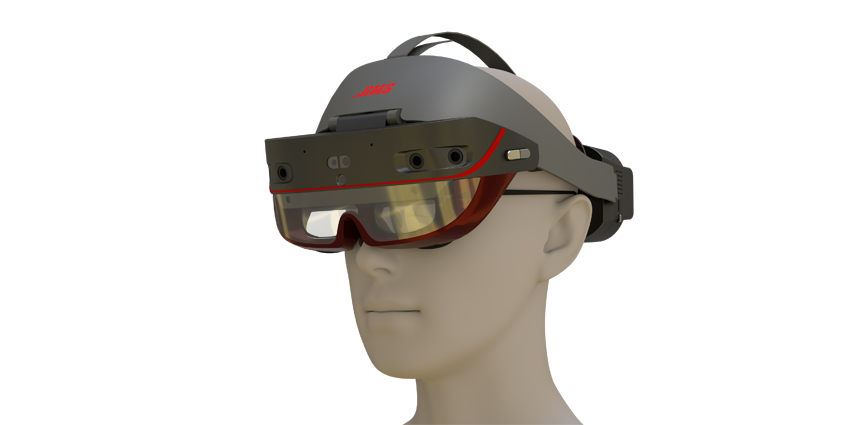If you read my previous Rokid Max AR glasses review from 2023, you’ll already know that I think Rokid’s specs are pretty impressive. The Rokid Max 2 glasses, which build on the previous model with a slightly sleeker design, are a decent upgrade.
Notably, I don’t think these glasses add much from a “technical specifications” perspective. The visuals are almost exactly the same, though you do get a slightly larger virtual screen. Plus, the audio doesn’t seem much different either. You even still get to bundle your glasses with the same android accessory for streaming (the Rokid Station).
Still, for a price that’s just a little higher than the previous Rokid Max specs, you can access bigger screens, and a design that looks a little bit less absurd.
Quick Verdict: Pros and Cons
Ultimately, the Rokid Max 2 glasses aren’t a world apart from their predecessors. When most companies release a new “version” of a set of augmented reality spectacles, we see a huge range of new features. Just look at the difference between the Snap Spectacles 4 and 5 models.
Rokid hasn’t changed much at all with this new edition of their flagship specs. However, that might be because the previous glasses were already excellent. The initial Rokid Max glasses are actually some of my favorite – affordable glasses for those who want access to an adjustable virtual display.
With the upgrade, you get a fantastic virtual screen (up to 360 inches at a distance of 10 meters), an excellent 50-degree field of view, and a brilliant 120hz refresh rate. Plus, you also get a slightly sleeker design, that definitely feels more comfortable in my opinion.
Pros:
- Sleeker design than the previous version
- Up to 360-inch virtual screen
- Excellent FOV and refresh rates
- Easy connectivity with the Rokid Station
- Decent noise-cancelling microphones
- Comfortable weight distribution
Cons:
- Not much of an upgrade from the previous model
- Picture brightness could be better
- Speakers are still limited
Rokid Max 2 Review: Overview and Specs
If you haven’t heard of the Rokid Max 2 – I’m not surprised. Rokid hasn’t made much of an effort to actively promote their “upgraded” flagship specs. That might be because they’re aware of how similar they are to the previous models. In fact, you won’t find the Rokid Max 2 glasses listed alone on the Rokid website’s product page.
The only way to really get a good look at the specs, and what they can do, or purchase them for yourself, is to visit the “Rokid AR Joy 2” page. Here, you’ll see two options for purchasing the Rokid Max 2 glasses. You can either purchase them on their own, or bundle them into the Rokid AR Joy 2 package, which includes the Rokid Station.
If you choose the bundle package, the specs for the Rokid Station are exactly the same. There are no upgrades here at all. You get the same 5-hour battery life, Bluetooth 5.0 connection, 64-bit quad-core ARM processor, and 2GB of memory.
The Rokid Max 2 Specs, are almost exactly the same as what you’d get on the initial Rokid Max glasses, with a few slight differences:
- Resolution: 1920 x 1080 pixels per eye
- Brightness: Up to 600 nits with 6 level controls
- Refresh rate: 120 Hz
- Field of View: 50 degrees
- Virtual screen size: 360 inches (at a distance of 10 meters)
- Color gamut: sRGB 106%
- Myopia adjustment: Real-time adjustment from 0.00D to -6.00D
- Weight: 75g
Rokid Max 2 Glasses: Design and Comfort
Let’s start, as usual, with the design. First of all, one thing I disliked about the initial Rokid Max glasses was their bulky (and slightly obnoxious) design. Although the initial specs were slimline enough, they were definitely a lot more conspicuous than most of the top AR glasses we see today.
Options like the XReal Air 2, and RayNeo X2 AR glasses, for instance, are still bulky, but they look a lot more like traditional spectacles than the Rokid Max glasses. Rokid still hasn’t managed to slim the Max 2 glasses down to a point where they’d compete aesthetically with something like the Meta Ray-Bans. However, the new models are a little sleeker.
The frames are very similar, with a large, flat, and slightly bulging set of lenses on the front. However, the new glasses are designed in a dark grey color that I think looks a lot better than the metallic blue of the initial Max glasses.
The arms of the glasses feel a little slimmer too. Although it’s worth noting that these glasses weigh exactly the same as their predecessors, so I might be imagining the difference. All of the elements of the glasses are located in the same place as they were on the initial Rokid Max too. You still get the pinhole microphone on the top of the bridge and the speakers on the inward-facing lenses.
The Comfort Factor
Ultimately, from a comfort perspective, there’s not a huge difference between the Rokid Max glasses, and the Max 2 specs. The weight is the same, the design is mostly the same, with the adjustable air nose pads, and the soft temple arms.
You also still get the diopter adjustment wheels on the upper right and left corners. That’s a good thing, as if you wear prescription glasses, you’ll be able to adjust the lenses for a sharper pictures without using separate lens inserts (although prescription lenses are available). Other specs, like the RayNeo Air 2S, don’t offer this feature.
Rokid Max 2: Lenses, Display Quality, and Audio
Though they look quite different to the original Rokid Max specs, the Max 2 glasses have most of the exact same features. There’s the same Micro-OLED system for the display, with a 1080p picture, and an impressive 50-degree field of view. I’ve noted before that this field of view is actually quite a bit better than what you’ll get from most AR competitors.
In comparison, for instance, the XReal Air 2, and the Viture XR Pro have a 46-degree field of view. That might not sound like a huge difference, but it does have a huge impact on your overall viewing experience – particularly if you’re watching videos or using large monitors with your specs.
The Picture and Brightness
The picture you get with the Max 2 specs is vibrant and sharp, with an excellent color performance, thanks to the high-quality micro-OLED projectors. Even with the wide-angle view, you don’t get much blurring around the edges of your virtual display.
Speaking of the actual virtual display – this is one of the few things that stands out compared to the previous Rokid Max glasses. The older glasses promised a 215-inch borderless screen from 6 meters away. The new specs promise an up to 360-inch screen from 10 meters away.
I also like the fact that the Max 2 glasses (like their predecessors) feature transparent outward-facing lenses, that deliver a kind of “sunglasses” effect, darkening your surroundings so your picture typically appears clearer. If you need better black-out results, you can use a shield that’s included in the package, to eliminate as much surrounding light as possible.
Obviously, this isn’t as convenient as having a built-in dimming function with electrochromic lenses, like you’d get from something like the XReal Air 2 Pro. Still, it’s a nice feature.
Where the Max 2 glasses suffer a little (just like the initial Max specs), is in brightness. Although you can toggle between six brightness levels with the buttons on the specs, the brightness maxes out at around 600 nits. Other glasses, like the Viture XR Pro boast around 1,000 nits of brightness. Still, the overall brightness level is decent enough most of the time.
If you’re going to be mostly using these glasses indoors, and you take advantage of the light shields included in the package, you shouldn’t have too much of a problem with clarity.
The Audio Experience
I didn’t have much to say about the audio experience offered by the Rokid Max glasses when I tried those in 2023. The same really applies to the Rokid Max 2 specs, as nothing much has changed. You still get a set of “private directional speakers” built into the glasses themselves. There’s also the same rocker on the arm to adjust your volume levels.
The speakers deliver excellent clarity, but there isn’t much bass or depth to speak of. Plus, although the speakers are designed to funnel sound directly into your ears – there is some leakage. The more you turn up the volume, the more people around you will be able to hear what you’re listening to.
That’s a common problem with most smart glasses offering integrated speakers, however, so I’m reluctant to mark Rokid down for this. On the plus side, you still get a set of integrated noise-cancelling microphones. You can use those for AI controls in various apps, or to make calls (through a connection to your phone). These microphones seem to be decent at capturing voice quite effectively, based on my experiments with a note-taking app, and a few calls.
Rokid Max 2 Review: Overall Performance
Using the Rokid Max 2 glasses will feel exactly like using the previous models. You must still connect your glasses to an external device using a standard USB-C to display port connection. However, this also means that you can use them with a wide range of Android phones and computers.
If you want to use your glasses with an unsupported device, you’ll need an adapter. Fortunately, Rokid offers a HDMI to USB-C adapter, alongside a variety of other accessories for the Rokid Max 2 glasses. There’s also the Rokid Hub (which enables passthrough charging), and Rokid’s standalone media hub – the Rokid Station.
The Rokid Station, which comes bundled into the Rokid AR Joy 2 package, is way more than just a bonus to the Max 2 glasses. It’s a powerful Android TV device, packing instant access to a range of Android apps and streaming options. It also doubles up as a reverse charger for your device – which is handy if you often see your battery life plummet when using connected specs.
The accessory is a brilliant tool if you want to control apps easily and immediately gain access to a range of content. However, it can be a little annoying to have an extra device connected to your smart glasses that you need to fumble with all the time.
If you want an even better upgrade for your Rokid Max 2 glasses, I’d recommend checking out the Rokid AR Lite kit, which includes the Rokid Station 2. That’s a much more advanced version of Rokid’s device, with a touch-screen display and upgraded technology that helps to enable multi-tasking and new spatial computing capabilities.
Rokid Max 2 Review: The Verdict
If you’re looking for a massive upgrade to the Rokid Max glasses, the Max 2 glasses probably aren’t going to blow you away. The style of the glasses is a little better, and the virtual screen you get can be a lot larger. However, most of the technical specs between the glasses are the same.
The biggest upgrades really come from combining the Rokid Max 2 with Rokid’s upgraded computing device – the Rokid Station 2. So, if you were planning on upgrading to the latest version of Rokid’s flagship glasses, I’d recommend bypassing the “AR Joy Kit 2”, and jumping straight to the AR Lite Kit instead. The small extra price you’ll pay for the Station 2 is definitely worthwhile, particularly if you’re using your glasses for work – as the new station is great for multitasking.
It’s also the first accessory from Rokid that supports 3DoF and multi-application functionality, and empowers you to connect your glasses to external devices, like a keyboard or mouse. You can learn all about the Rokid AR Lite Kit here.







